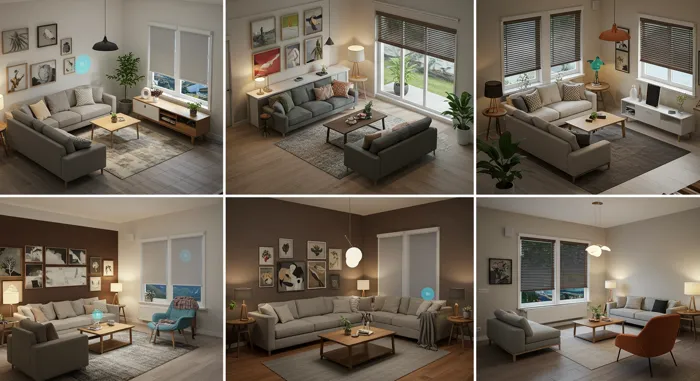The living room is where everything blends together: memories, quiet nights, and bursts of laughter. It’s the place where life unfolds, whether you’re hosting friends or sinking into the sofa after a long day. Building a space that feels inviting and works for your everyday routine starts with smart layout choices.
No matter if your room is snug and cozy, large and open, or shaped like nothing you’ve ever seen before, the right furniture arrangement can completely shift how your living space feels and functions. With a little imagination and the right guide, even the trickiest room can be made to feel balanced, livable, and totally you.
This guide walks you through layout styles made for all kinds of homes, helping you shape a living room that’s functional, personal, and full of character.
Classic Living Room Layout Templates
Classic layouts stick with tried and true setups that keep things cozy, open, and ready for anything. Whether your space is small or wide, these timeless templates bring ease to planning where the seating, tables, and TV should go.
1. Sofa Plus Two Chairs Facing TV
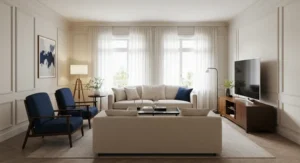
A sofa positioned straight across from the TV, with two chairs angled nearby, gives everyone a clear view while making conversations feel easy. Pick a sofa shape that flows with your layout and keeps movement natural.
2. Sectional plus Coffee Table Combo

A sectional paired with a coffee table at its center invites guests to gather without feeling boxed in. Ideal for open rooms that call for comfort and space to stretch out.
3. L-Shaped Conversational Area

By forming an L with your seating, you create a natural nook for talking and relaxing. It fits well into corners or medium-sized spaces that need structure without walls.
4. Floating Layout with Furniture Off the Walls
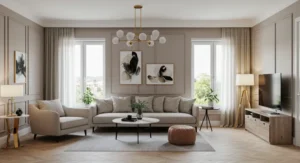
Moving furniture away from the walls gives the room a lighter feel and makes footpaths more flexible. This layout is great for creating open movement in a relaxed way.
5. U-Shaped Seating with Focal Point
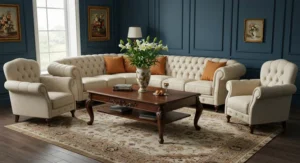
Chairs and a sofa forming a U around a centerpiece like a TV or coffee table keeps people close without crowding. This layout works well in larger rooms where a cozy center feels inviting.
Small Living Room Layout Ideas
Small spaces call for creativity. These layouts focus on keeping things functional, open, and smart without giving up your sense of style or comfort.
1. Wall-Mounted Storage and Narrow Seating
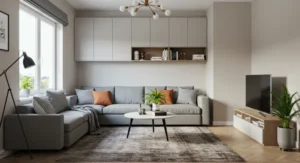
Going vertical with storage and picking slimmer seats opens up the room while keeping essentials close. Every inch counts in a compact setup.
2. Floating Furniture with Open Floor Center

Pulling furniture inward instead of pushing to the walls clears up the middle and adds breathing space. A smart layout for tight quarters with lots of foot traffic.
3. Vertical Zoning Using Rugs and Lighting

Strategic rug placements and layered lights can define areas without needing walls. Pair this zoning approach with some cozy lighting inspiration for a warm and relaxed effect.
4. Multipurpose Furniture Arrangements
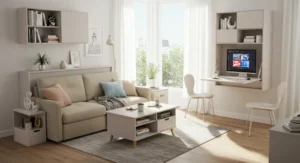
Pieces like storage ottomans and convertible sofas serve more than one purpose. Try pairing them with rug ideas for small spaces to round out the layout without clutter.
Long and Rectangular Room Solutions
Long or narrow rooms need layouts that break up the length and avoid the tunnel feel. These ideas help shape balance while maintaining walkways and function.
1. Zoning into Two Seating Zones
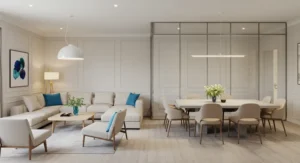
Breaking up the room into two conversation areas gives the space definition and lets people use the room in different ways.
2. Couch and Accent Chair Alignment
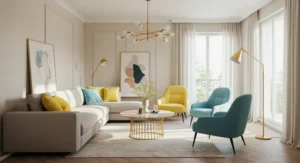
Placing a sofa and a side chair along one wall keeps things linear but not rigid. This layout keeps traffic flowing without blocking light or views.
3. Side-by-Side Symmetry Placement
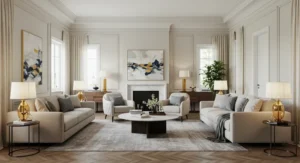
Mirroring furniture on both sides creates visual balance and calm. It’s an easy way to make a room feel organized without overthinking the details.
4. Split Rug Sections to Open Up Space

Two rugs can visually divide the space into sections. Layer your rugs this way to bring shape and focus into an extra-long room.
Living Rooms with Bay Windows, Fireplaces and TV Units
Rooms with strong architectural features work best when you let those features lead. These layouts help you blend your setup around what’s already making a statement.
1. TV Between Bay Windows

Positioning the TV between bay windows lets you enjoy the view while keeping the setup focused. It balances light and screen time in a smart way.
2. Angled Furniture Around the Fireplace
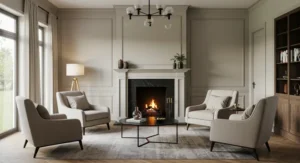
Placing chairs at angles near the fireplace makes the room feel welcoming and warm. It keeps walkways clear while giving the fireplace a chance to stand out.
3. Two Focal Points with TV and Fireplace
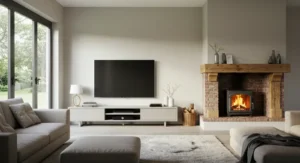
With both a fireplace and TV, your furniture should acknowledge each without crowding either. This layout keeps both entertainment and comfort in mind.
4. Bay Window Reading Corner Design

A simple chair and side table turn the bay window into your favorite reading spot. Dress it up with curtain ideas that soften the light without blocking it completely.
Open Concept and Large Living Room Arrangements
Large living rooms and open floor plans have flexibility but need structure to avoid feeling scattered. These layout ideas carve out zones while keeping everything connected.
1. Dividing Zones with Rugs and Lighting

Use large rugs and lighting clusters to create distinct spaces for dining, lounging, or reading. They shape the space without needing any physical walls.
2. Walkways Through Floating Sofas

Let sofas float instead of pressing them against walls. This naturally forms walkways and keeps the center area open and easy to move through.
Actionable Layout Tips and Visual Planning Tools
Before you move a single chair, try mapping your layout using simple tricks and free planning tools. These methods help you get the feel of the space before committing to a design.
- Map Out with Painter’s Tape
Laying tape where furniture will go helps you picture the space clearly. It’s a quick and cost-free way to try things out without lifting heavy pieces.
- Visual Hierarchy Height Weight Balance
Balance comes from how furniture looks together. Tall, wide, or heavy pieces need balance across the room. The right mix keeps your space feeling calm and open.
- Apps and Free Tools for Layout Simulation
Using apps to simulate furniture placement offers a risk-free way to try different layouts. These tools provide 2D and 3D views, making it easier to finalize decisions.
When selecting colors and finishes, also explore fresh paint and color inspirations to complement your layout choices.
FAQs:
Keep the TV on the main wall and select slim seating. Use the wall space efficiently and leave the center open for easier movement.
Divide it into separate seating areas and leave walking paths open. Use rugs or tables to anchor each space visually.
Furniture groupings, layered lighting, and rug placements all help define zones without needing partitions.
No. Mix it up by facing some seating toward each other for conversation, while others face the screen. This gives your space a more dynamic feel.
Set up a chair and side table in the nook, and use layered window treatments. The result is a comfortable corner filled with natural light. How can I arrange a small living room with a TV?
How do you furnish a rectangular room?
How can I establish zones in an open-plan living room space?
Do all pieces of furniture have to face the TV in a design? Why or why not?
What makes an effective bay window design?
